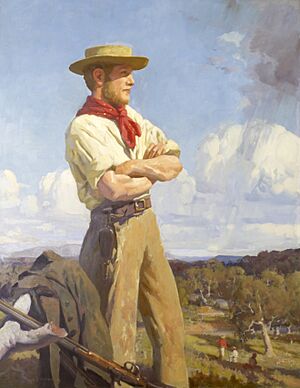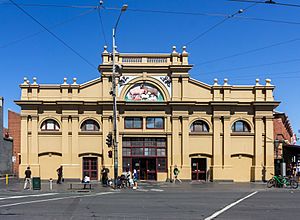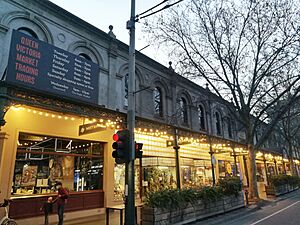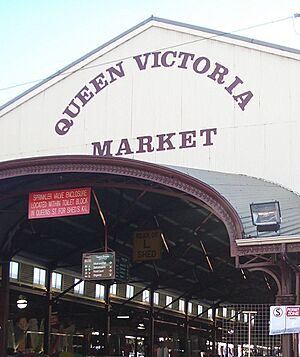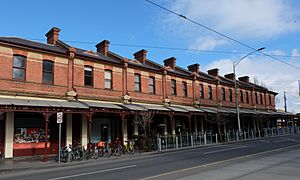Queen Victoria Market facts for kids
Quick facts for kids Queen Victoria Market |
|
|---|---|

Aerial photograph of Queen Victoria Market
|
|
| General information | |
| Status | National Heritage List |
| Type | Public food, produce and flea market |
| Location | Melbourne, Victoria, Australia |
| Coordinates | 37°48′25″S 144°57′25″E / 37.8070°S 144.9569°E |
| Completed | 1878 |
| Owner | Queen Victoria Market Pty Ltd |
The Queen Victoria Market is a famous public market in Melbourne, Australia. People often call it the Vic Market or Queen Vic. It's right in the middle of Melbourne's city centre.
This huge market covers about 7 hectares (that's like 17 football fields!). It's the biggest open-air market in the Southern Hemisphere. Imagine all that space filled with amazing things!
The market started being built in the 1860s and officially opened in 1878. It's one of the last big markets from Melbourne's early days that is still running. The Queen Victoria Market is a special place. It's listed on important heritage registers because of its history.
It's also one of Melbourne's top tourist spots. Around 10 million people visit every year! They come to explore, shop, and enjoy the lively atmosphere.
Contents
A Look Back: The Market's History
Melbourne's First Markets
Before the Queen Victoria Market, Melbourne had other places to buy fresh food. The Western Market was the first official fruit and vegetable market. It started in 1841, just six years after Melbourne was founded.
As Melbourne grew, another market, the Eastern Market, opened. It quickly became very popular. These early markets helped feed the city's growing population.
From Cemetery to Market Ground
A big part of the Queen Victoria Market was built over an old cemetery. This was Melbourne's very first British burial ground. Many of Melbourne's first settlers, like city founder John Batman, were buried there.
The cemetery stopped new burials in 1854. However, some burials continued for many years. By 1920, experts thought about 10,000 graves were on the site. Sadly, the exact number is unknown because the cemetery records were lost in a fire.
How the Market Area Grew
After the cemetery was partly closed, smaller markets popped up nearby. These served Melbourne's fast-growing population in the late 1850s. One area was first planned for a fruit and vegetable market in 1857. But its closeness to the cemetery made it unpopular.
Instead, this area was used for livestock and hay until 1867. Then, a strong brick building was put up. This building is now known as the Meat and Fish Hall. It's the oldest building still standing at the market today.
In 1876, the government decided to officially turn the old cemetery site into market land. A year later, construction began on one part of the cemetery. Before building, 28 skeletons were carefully moved to another cemetery.
The Grand Opening of Queen Victoria Market
The Queen Victoria Market officially opened in March 1878. It quickly became a busy place for selling fruits and vegetables. This led to more sheds being built. Shops were added along Elizabeth Street in 1880. The famous front of the Meat and Fish Hall was built in 1884.
By 1898, hundreds of carts full of fresh produce arrived twice a week. They came from market gardens outside the city to sell their goods. The market was a vital part of Melbourne life.
Expanding the Market Space
In 1920, work began to make the market even bigger. This meant building over more of the old cemetery. Some people were very upset about this plan. Sir John Monash, a famous Australian, spoke out against it. He felt it showed a lack of respect for history.
Despite protests, the work went ahead. Between 1920 and 1922, 914 bodies were moved to other cemeteries. By 1923, most of the early settlers' remains had been relocated. The rest of the old cemetery was then prepared for market expansion. New sheds were built, and the market grew to cover two city blocks.
Later, in 1930, sixty brick stores were built for wholesale agents. However, problems with how things were run led to changes. The wholesale market eventually moved to Footscray in 1969. Today, only a row of shopfronts along Franklin Street remains from those stores.
Saving the Market from Demolition
In the 1960s and 1970s, there were plans to knock down the market. One idea was to turn it into a huge car park. Another plan was to build offices and hotels.
But people loved the market and fought to save it. Public protests and a special "green ban" helped stop these plans. A green ban is when workers refuse to work on projects that harm the environment or heritage. Because of these efforts, the market was protected. It was listed as a historic site.
The Market Today
The Queen Victoria Market is still a thriving place today. It's the biggest and most complete of Melbourne's old 19th-century markets. It's a major attraction for visitors and a special part of Melbourne's culture.
The market is open most days, except Mondays and Wednesdays. On some evenings, especially in summer and winter, a night market takes place. It offers delicious food, drinks, live music, and many different stalls. You can find fresh fruits, vegetables, meat, seafood, and gourmet foods. There are also stalls selling clothes, shoes, jewellery, and handmade crafts.
The market has had some updates over the years. In 2003, solar panels were installed. They create enough energy to power all the market's businesses and even have extra! In 2010, there was talk of making the market even more special. The Lord Mayor wanted to add more unique food stalls, like famous markets in London.
In 2015, the City of Melbourne put aside a lot of money to invest in the market. There were also plans to nominate the market as a UNESCO World Heritage Site. This would recognize its global importance.
Market Architecture: A Glimpse into the Past
Many of the market's original buildings are still standing. They let visitors see what a 19th-century streetscape looked like. The Meat Hall, built in 1869, is mostly unchanged and is the oldest building.
The front of the Elizabeth Street shops, built in 1884, also looks much like it did then. The retail rows on Elizabeth and Victoria Streets, built between 1882 and 1891, are very important. They offer a unique chance to shop in a historic setting.
See also
- Metropolitan Meat Market – another old Melbourne market, now an arts centre
- Prahran Market
- South Melbourne Market
- List of heritage-listed buildings in Melbourne


